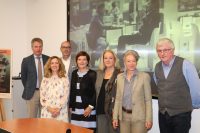
Newsletter October 2018

Back from the summer holidays, we are delighted to announce some very good news indeed. A major part of the documentary estate owned by the Fassbinder Foundation and all other documents, exhibits, photos and production records are to be transferred on permanent loan to the German Film Institute (DIF) and Film Museum (DFM). April next year will see the opening on Eschersheimer Landstrasse in Frankfurt am Main of the Fassbinder Center, a “dynamic, publically accessible research facility”, which will also “be used for lectures, screenings and other public programs throughout the year”. (More information can be found on the website of the DIF: https://deutsches-filminstitut.de/fassbinder-center-frankfurt/). The transfer is taking place thanks to generous support provided by the Hessian Cultural Foundation, the Cultural Foundation of the German Federal States and the City of Frankfurt am Main.
The estate, which is currently stored in more than 180 archive boxes, consists of 25 shooting scripts, 97 mostly handwritten scene sequences, as well as scene set-ups and dialog lists, staff lists and shooting plans, production documents and financing plans, along with letters, telegrams and certificates. The rest of the RWFF’s collection includes an archive made up of works, photos and international press coverage, 3D objects – including Fassbinder’s pinball machine and his legendary leather sofa – his video collection and a comprehensive audio and video archive containing all interviews with RWF and documentation about him.
In her article for the Frankfurter Allgemeine Zeitung Verena Lueken writes, “During the press conference a series of photos was projected behind the speakers. […] Pictures of Fassbinder between his actors; with a megaphone during shooting; demonstrating a pose in rehearsal; reflective, melancholic, concentrated, sexy, provocative, inquisitive, lost, cool – photos that arouse a desire to see his films, a desire to once again immerse oneself in the world of images and stories that he devised. Like all art Fassbinder’s films are not interpretable down to the last detail. This makes them a challenge for every generation. In Frankfurt a framework has now been established that invites a re-exploration of this body of work in all its expansiveness.” The entire article is available at: http://www.faz.net/aktuell/feuilleton/kino/frankfurt-bekommt-ein-fassbinder-center-15786853.html
Another article well worth reading about the new “house for RWF” is available on the website of the Frankfurter Rundschau: http://www.fr.de/kultur/kino/rainer-werner-fassbinder-ein-haus-fuer-rwf-a-1581932
A visit to the DFM is always worth the time, and this is particularly the case from 23 October onwards, when the exhibition “Hautnah. Die Filmkostüme von Barbara Baum” (Up Close – the film costumes of Barbara Baum) opens. Baum, who during her career specialized above all in historical films, has clothed stars such as Meryl Streep, Jeanne Moreau and Burt Lancaster and worked with directors including Hans-Jürgen Syberberg, Bille August and Reinhard Hauff. However, she is above all known for her many years of collaboration with Fassbinder and the costumes she created for films such as LOLA (1981), VERONIKA VOSS and QUERELLE (both 1982).
When she was young Barbara Baum saw her future somewhat differently to how it actually turned out, as she told the newspaper DIE ZEIT some years ago: “I once dreamed of becoming an actress. But my dear mother wanted me first to learn a proper skill. As a result it was handicraft that first led me indirectly to film, where I was ultimately able, with Fassbinder, to play some small roles: a lady of the manor in EFFI BRIEST (1974), a patient in THE MARRIAGE OF MARIA BRAUN (1978). Looking back I think that I made exactly the right career choice. […] I was able to work on wonderful projects, and, unlike in the acting world, in my profession age does not play a role.” (The entire text is available at: https://www.zeit.de/zeit-magazin/2015/25/barbara-baum-traum).
The exhibition runs until 10 March and is being accompanied by a series of films and workshop discussions on costume design as a profession in Germany. More information can be found on the DIF website: https://deutsches-filminstitut.de/hautnah/)
In conclusion, we have some sad news. On 16 August the producer Gunther Witte, known as the inventor of the renowned German police procedural TATORT, died at the age of 82. From 1979 to 1998 Witte worked as an editor for the broadcaster WDR. During in this time he also co-produced Fassbinder’s BERLIN ALEXANDERPLATZ (1980). The Fassbinder Foundation valued him not only as a supporter but also as a wonderful interlocutor and friend.
We would like to wish our friends and readers a pleasant start to the autumn and will return again in a month with more news from the world of Rainer Werner Fassbinder.
More on the films of Rainer Werner Fassbinder:
http://www.fassbinderfoundation.de/filme-von-fassbinder/?lang=en
Photo left: Exhibits from the documents archive of the newly founded Fassbinder Center Frankfurt © DIF / Photographer: Jakob Maurer
Photo right: Press conference Fassbinder Center, left to right: Dr. Ulrich Adolphs, Ellen Harrington, Prof. Dr. Frank Druffner, Eva Claudia Scholtz, Juliane Maria Lorenz-Wehling, Ina Hartwig, Hans-Peter Reichmann © DIF / Photographer: Jakob Maurer